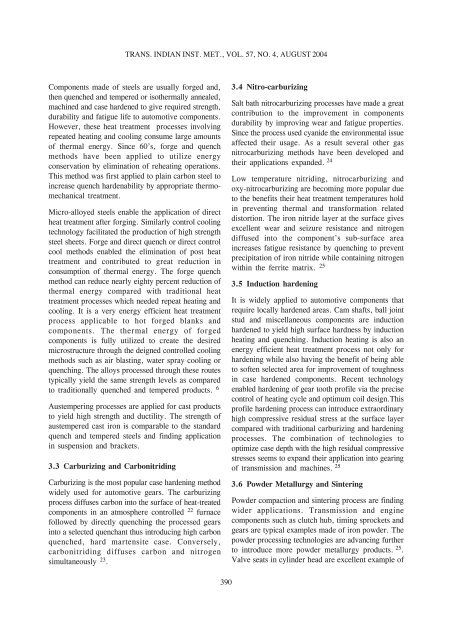HEAT TREATMENT OF AUTOMOTIVE COMPONENTS: CURRENT ...
HEAT TREATMENT OF AUTOMOTIVE COMPONENTS: CURRENT ...
HEAT TREATMENT OF AUTOMOTIVE COMPONENTS: CURRENT ...
You also want an ePaper? Increase the reach of your titles
YUMPU automatically turns print PDFs into web optimized ePapers that Google loves.
TRANS. INDIAN INST. MET., VOL. 57, NO. 4, AUGUST 2004<br />
Components made of steels are usually forged and,<br />
then quenched and tempered or isothermally annealed,<br />
machined and case hardened to give required strength,<br />
durability and fatigue life to automotive components.<br />
However, these heat treatment processes involving<br />
repeated heating and cooling consume large amounts<br />
of thermal energy. Since 60’s, forge and quench<br />
methods have been applied to utilize energy<br />
conservation by elimination of reheating operations.<br />
This method was first applied to plain carbon steel to<br />
increase quench hardenability by appropriate thermomechanical<br />
treatment.<br />
Micro-alloyed steels enable the application of direct<br />
heat treatment after forging. Similarly control cooling<br />
technology facilitated the production of high strength<br />
steel sheets. Forge and direct quench or direct control<br />
cool methods enabled the elimination of post heat<br />
treatment and contributed to great reduction in<br />
consumption of thermal energy. The forge quench<br />
method can reduce nearly eighty percent reduction of<br />
thermal energy compared with traditional heat<br />
treatment processes which needed repeat heating and<br />
cooling. It is a very energy efficient heat treatment<br />
process applicable to hot forged blanks and<br />
components. The thermal energy of forged<br />
components is fully utilized to create the desired<br />
microstructure through the deigned controlled cooling<br />
methods such as air blasting, water spray cooling or<br />
quenching. The alloys processed through these routes<br />
typically yield the same strength levels as compared<br />
to traditionally quenched and tempered products. 6<br />
Austempering processes are applied for cast products<br />
to yield high strength and ductility. The strength of<br />
austempered cast iron is comparable to the standard<br />
quench and tempered steels and finding application<br />
in suspension and brackets.<br />
3.3 Carburizing and Carbonitriding<br />
Carburizing is the most popular case hardening method<br />
widely used for automotive gears. The carburizing<br />
process diffuses carbon into the surface of heat-treated<br />
components in an atmosphere controlled 22 furnace<br />
followed by directly quenching the processed gears<br />
into a selected quenchant thus introducing high carbon<br />
quenched, hard martensite case. Conversely,<br />
carbonitriding diffuses carbon and nitrogen<br />
simultaneously 23 .<br />
3.4 Nitro-carburizing<br />
Salt bath nitrocarburizing processes have made a great<br />
contribution to the improvement in components<br />
durability by improving wear and fatigue properties.<br />
Since the process used cyanide the environmental issue<br />
affected their usage. As a result several other gas<br />
nitrocarburizing methods have been developed and<br />
their applications expanded. 24<br />
Low temperature nitriding, nitrocarburizing and<br />
oxy-nitrocarburizing are becoming more popular due<br />
to the benefits their heat treatment temperatures hold<br />
in preventing thermal and transformation related<br />
distortion. The iron nitride layer at the surface gives<br />
excellent wear and seizure resistance and nitrogen<br />
diffused into the component’s sub-surface area<br />
increases fatigue resistance by quenching to prevent<br />
precipitation of iron nitride while containing nitrogen<br />
within the ferrite matrix. 25<br />
3.5 Induction hardening<br />
It is widely applied to automotive components that<br />
require locally hardened areas. Cam shafts, ball joint<br />
stud and miscellaneous components are induction<br />
hardened to yield high surface hardness by induction<br />
heating and quenching. Induction heating is also an<br />
energy efficient heat treatment process not only for<br />
hardening while also having the benefit of being able<br />
to soften selected area for improvement of toughness<br />
in case hardened components. Recent technology<br />
enabled hardening of gear tooth profile via the precise<br />
control of heating cycle and optimum coil design.This<br />
profile hardening process can introduce extraordinary<br />
high compressive residual stress at the surface layer<br />
compared with traditional carburizing and hardening<br />
processes. The combination of technologies to<br />
optimize case depth with the high residual compressive<br />
stresses seems to expand their application into gearing<br />
of transmission and machines. 25<br />
3.6 Powder Metallurgy and Sintering<br />
Powder compaction and sintering process are finding<br />
wider applications. Transmission and engine<br />
components such as clutch hub, timing sprockets and<br />
gears are typical examples made of iron powder. The<br />
powder processing technologies are advancing further<br />
to introduce more powder metallurgy products. 25 .<br />
Valve seats in cylinder head are excellent example of<br />
390
















